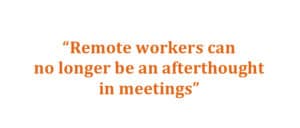It probably won’t surprise you that the demand for online collaboration tools such as Microsoft Teams has spiked significantly with the worldwide Coronavirus outbreak.
With lockdown in full force in many countries, Microsoft Teams usage alone doubled to over 44 million users by late March 2020, and the Microsoft’s Teams chat and conferencing app gained more than 12 million daily users in just one week in March.
And Zoom, the popular video conferencing tool, recorded a 30 times year-on-year increase in daily app downloads, with daily users spiking to 200 million in March 2020, up from 10 million in December 2019.
While these figures are very much a reflection of the vast numbers of employees currently working remotely due to coronavirus restrictions, what is more interesting is the likely more permanent and fundamental shift in work habits.
The New Normal of Work
1. Get used to working from home
Despite some work restrictions being lifted in countries like China and Singapore, work patterns have not gone back to normal office attendance. Companies are tending to implement things like staggered shifts, and alternate ‘in office’ days. This may well become the norm in the short to medium term, and in the case of ongoing localised outbreaks, companies may well revert back to remote work only.
Although this isn’t always the case, the current situation has demonstrated that the vast majority of employees can actually work from home effectively using online collaboration tools. In a recent Gallup survey, a whopping 60% of American workers confirmed they would prefer to work remotely as much as possible, even after public health restrictions are lifted.
“Once effective work-from-home policies are established, they are likely to stick,” said Karen Harris, managing director of consultancy Bain’s Macro Trends Group in New York.
Australian staff surveys also confirm strong support for working from home as an ongoing option.
2. Work-from-home employees no longer an afterthought
 Microsoft is also seeing cases where remote workers can no longer be an afterthought in meetings, and how chat can influence video calls.
Microsoft is also seeing cases where remote workers can no longer be an afterthought in meetings, and how chat can influence video calls.
“The simplest example is how important chat becomes as part of a meeting,” says Jarad Spataro, head of Microsoft 365.
“We’re not seeing it as being incidental anymore, we’re actually seeing it be a new modality for people to contribute to the meeting.”
This could involve people chatting alongside video meetings, and providing real time feedback.
3. Changing use of video and other collaboration technology

Protecting employees in a post-COVID world may mean face-to-face meetings and travel are reduced or eliminated and replaced with online collaboration including phone, chat and video. Do you really need to travel across town, interstate or overseas when you can easily, safely and cost-effectively communicate using tools like Microsoft Teams?
Interestingly, working from home has also inspired people to turn on video 2x more than before the outbreak, when they may have just utilised a traditional audio call.
4. Job transformation
Coronavirus restrictions have limited or eliminated the tasks that some employees perform. There are currently no clients to consult, no trips to book, no events to organise and no receptions to manage.
This is forcing employees to reimagine their role and take on new responsibilities. Employees are becoming work-from-home coordinators, crisis managers and taking on numerous other online and collaboration tasks that did not exist a few months ago.
5. The changing landscape of the office
Offices will no doubt still exist after the epidemic passes, however, they may be transformed. If a significant number of employees continue to work from home, large office spaces may reduce in size, or the layouts may change due to social distancing requirements. There may even be more video conferencing spaces and tools incorporated into the layout to provide a more seemless connection between office and remote employees.
5. A better bottom line
There is also a strong business case for reduced company travel and increased working from home.
A number of work productivity surveys have confirmed that employees working from home take fewer breaks, are less distracted and more productive.
Access Economics has predicted that if 10 per cent of people worked from home the economic benefit would be almost $2 billion each year.
Greater flexibility and the removal or reduction in weekly commuting can also have a positive impact on work flexibility, staff moral and well-being.
Is your business prepared?
It’s hard to predict exactly what will happen and when, and it will certainly vary by industry, but it is highly likely that there will be a more permanent and fundamental shift in work habits.
Prepare your organisation by ensuring your hardware and collaboration tools can meet your future business needs.
Speak to Surety IT today for expert advice on how Microsoft Teams Collaboration tools and Microsoft Teams Calling solutions can be tailored to your business needs and easily scaled for future requirements.




